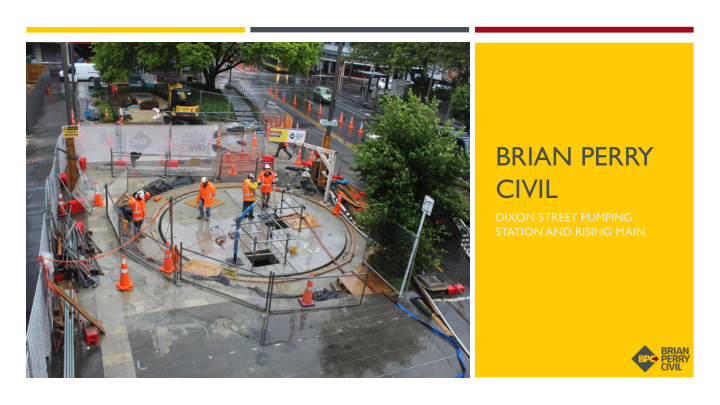



BRIAN PERRY CIVIL DIXON STREET PUMPING STATION AND RISING MAIN
BRIAN PERRY CIVIL Established by Brian Perry in 1954, Brian From its origins in drainage work in the The Company was bought by Fletcher Perry Civil is a contractor with a reputation Waikato, the Company progressed to river Construction in 1986 and is now for performance, innovation and quality in and marine works, energy pipelines, civil undertaking civil engineering projects ranging high risk civil engineering projects. structures and foundation work. Operations from small drainage jobs to major expanded geographically around New infrastructure projects. Zealand and to the South Pacific Islands.
Brian Perry Civil expanded their BPC Wellington have carried out a vast operations in to the Wellington market portfolio of notable piling and ground in 1989. This year marks 30 years of improvement projects throughout the operation in the Wellington Region. Wellington Region. BRIAN PERRY CIVIL WELLINGTON
PROJECTS ORIENTAL BAY ENHANCEMENT WELLINGTON MAJESTIC CENTRE KUMOTOTO CENTREPORT NGAURANGA TO AOTEA QUAY WHIROKINO TRESTLE AND JOHNSONVILLE TRIANGLE MACKAYS TO PEKA PEKA SMART MOTORWAY MANAWATU RIVER BRIDGE IMPROVEMENTS EXPRESSWAY
DIXON STREET PUMPING STATION AND RISING MAIN Construction of a new 6.5m diameter, 7m deep underground pumping station Mechanical fit-out 175m of new rising main Located on a contaminated land site in Wellington CBD. Constructed to accommodate the additional flows of the new developments, alleviating capacity issues in the downstream network. First PS to be constructed in the CBD in over 40 years.
SEGMENTAL PRECAST CAISSON SYSTEM BPC submitted a proposal based a segmental precast caisson system. A market review highlighted the lack of a suitable supplier of concrete segments within New Zealand and Australia. We contacted FP McCann in the UK which had a supply of 6.5m diameter segments in stock. Traditional methods would have involved overdigging the extent of the excavation to provide working room to construct the structure.
COLLABORATION The ECI and construction required extensive liaising and collaborative engagement with GHD to finalise and implement the testing and design phases. To the best of our knowledge this is the first time this technology has been used in New Zealand. Thus, this system has not been proven in a seismic environment. BPC worked collaboratively with GHD, and our sub consultant Arup, to finalise the design and to ensure that the segmental caisson and the internal walls could be designed to perform effectively in an earthquake. This work included: Assessing ground conditions Seismic modelling and; Defining structural performance requirements BPC produced a 3D model to visualise the new pump station layout.
SEGMENTAL CAISSON By opting to use a segmental caisson: No requirement for large scale temporary works (shoring). Absolute minimum footprint of the excavation, thereby reducing the volume of material to be excavated, minimising the volume of contaminated material to be removed. The minimised footprint allowed us to position a 6.5m diameter structure on the site, without the need to close Feltex Lane.
HEALTH & SAFETY During the planning stage, it was noted that one of our greatest health and safety risks was going to be safe access, egress and ventilation of the work space. The nature of a segmental caisson allows all work to be carried out safely from ground level. The 7.5m deep caisson excavation and external structure was completed without any workers entering the caisson
RECIPE FOR SUCCESS The RFP included small number of drawings that inferred that the client was open to ‘ Another Way ’ to construct the project Responses to questions during the RFP re-affirmed the desire to want to do things differently; no unnecessary provision for Risks Extensive and open dialogue during the ‘ Preferred T ender ’ stage clarified responsibilities and mitigate outstanding risks All parties entered into the project with the knowledge that decisions were being made ‘Best for Project ’; scope, role and responsibilities were all understood. Result: The contract was ‘ Administrative ’ not ‘ Adversarial ’
AWARDS Civil Contractors New Zealand Wellington / Wairarapa Branch Project of the Year Award 2019 Finalist in the Civil Contractors New Zealand National Awards 2019 Finalist in the Fletcher Building Excellence Awards Outstanding Customer Leading Team 2019 Institute of Public Works Engineering Australasia NZ Engineer Awards Best Public Works Project under $5m 2019
THANKYOU! ANY QUESTIONS?
Recommend
More recommend